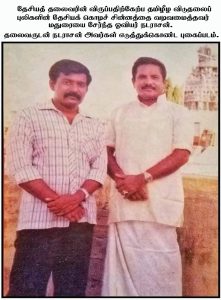

Tamil Eelam National Flag
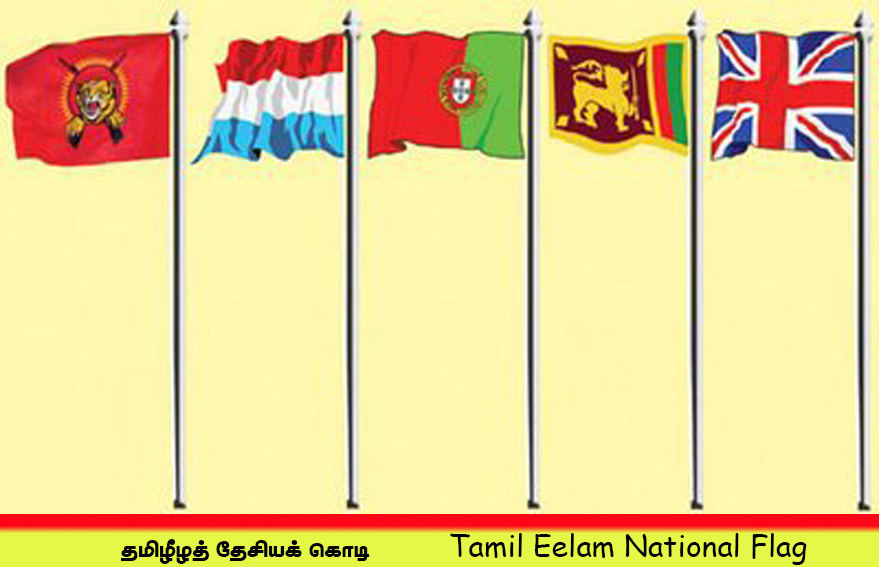
- Preface
All the countries in the world have created their own national flag. The salutation of the national flag is an expression of the value and devotion that the citizens of that country have towards their country. After the hoisting of the national flag, the main ceremonies and events begin in each country.
While the struggle for the complete liberation of Tamil Eelam is in full swing, our National Leader has hoisted the national flag for Tamil Eelam, which has been reclaimed at the cost of thousands of lives of martyrs.
Even before the formation of the country, the people of Tamil Eelam have added a novelty to the history of the national flag by paying homage to the flag, playing the national song, and conducting major ceremonies and events.
We are proud to publish this handbook, “The National Flag Usage Rules” so that all the people of Tamil Eelam should know how to hoist and respect our national flag, which has an innovative history.
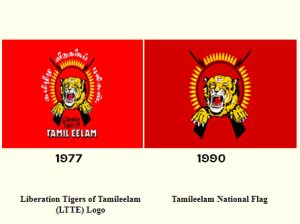 The nature of the national flag
The nature of the national flag
The national flag is the overall common symbol of a country, including its national races, the characteristics of its people, its rule, and its sovereignty.
- The structure and size of the national flag
The symbol, color, size, and structure of the national flag of each country differ as an expression of their nature, conditions, and thoughts. The lengths and widths of national flags are often 3:2. In some countries, the national flags are 2: 1 long and 2: 1 wide, while in others they are 1: 1 square.
- Pride of the national flag and salute of the flag
The national flag is saluted as a tribute to the country. Worshiping the national flag is like worshiping the country. The national flag is highly regarded as the leader, force, and government of the country. That is why in any country, at any special event, the president of the country, the soldier, the civil servant, and the citizens all salute the flag.
The national flag can be flown daily in the border areas of the country and in certain public places.
We can fly our national flag during the day at our offices and embassies abroad.
Everyone should stand up and salute when the national flag is being hoisted.
During the flag salute, uniformed personnel (battalions, scout operators, first aid people, etc.) will pay homage to the flag as prescribed in the respective orders.
Only people in uniform can wear a cap during hoisting the national flag. If a cap is worn by anyone other, they have to remove it, place the right hand on the left chest and salute the flag. Non-Tamil Eelam citizens can also place their right hand on the left chest and salute. Or stand in attention.
The national flag should not be worn as a dress or as part of a dress.
The emblem of the national flag may be engraved on valuables things or clothing.
No symbols, letters, words, numbers, shapes, or pictures shall be written or drawn on the national flag. The national flag should not be affixed to anything that is used and thrown away temporarily.
The national flag should never be dropped on the ground. Perhaps the situation should be rectified immediately if it falls to the ground. If the national flag is dirty, immediately wash and dry it before using it again.
The grief of the country is conveyed by the hoisting of the national flag at half-mast during the national tragedy event. The flag is flying at the apex of the flagpole is lowered to the middle and flown at half-mast to symbolize the greatness of the country.
If the color of the national flag fades or loses its ability to fly in some other way, it must be properly burned and destroyed. Destruction of the flag should be done by special rules too. It is an insult to the nation to use it as a piece of cloth or put it in the trash.
- Things not to do during flag hoisting and flag worship
Just as the value and specialty accorded to the national flag reach that country, so the contempt and disregard for the national flag will reach its own country. That is why the desecration of the national flag is considered a felony and the offense is given the maximum punishment.
A well-organized and uniform regulation for the flag-worshiping event that pays homage to the national flag is defined and implemented. The regulation and practice of flag hoisting and flag worship vary from country to country. Violation of those defined disciplines would be considered an insult to the national flag.
The national flag should not be flown upside down.
The national flag should not be loaded so that it can be folded up and spread out. The national flag must be flown from below.
- Debit with flag
Even the carrying of the national flag during processions for special events is a tribute to the value paid to the national flag. Those who hoist the national flag and guard the flagpole will not allow the national flag to fall or the flagpole to fall.
The bearer of the national flag will hoist the flag at the appropriate place upon completion of duty. The flag will not be dropped by anyone. Literature and history tell of the Tamils’ attachment to the country’s flag and the value it placed on it in ancient times.
- History of the National Flag of Tamil Eelam
The tiger flag created by our leader Prabhakaran Velupillai has been the flag of the Liberation Tigers of Tamil Eelam (LTTE) since 1977. In 1990, the leader of the Liberation Tigers of Tamil Eelam (LTTE) declared the LTTE flag as the national flag of Tamil Eelam, after removing the writings on the flag. The first commemoration of the flag was held on 27th Novemver 1990, just before the second years’ Maveerar remembrance day (Heroes´Day) by the national leader at his place.
- Colors and purpose
The four colors of our national flag are yellow, red, black, and white. The individual national race, the Tamil Eelam national race, seeks to establish autonomy on its own soil with its basic political and human rights. The yellow color signifies that the national liberation struggle of the people of Tamil Eelam is virtuous, just and that Tamil Eelam will always stand by virtue.
The establishment of a national liberated Tamil Eelam state alone cannot be considered a complete liberation. Inequalities in Tamil Eelam must also be eliminated. Caste and class differences should be eliminated. The oppression of women must be eliminated. This requires revolutionary changes in the society system. Equality and collective justice must be upheld. The red color symbolizes our political goal of praying for such a revolutionary coup.
The path to liberation is rough; It was full of death, destruction, and unbearable suffering. We need a firm heart like steel to withstand these and to build and defend the nation in the face of the crises and threats that will arise after liberation; Have unwavering faith; Make sure not to loosen. These are indicated by the black color.
White stands for the liberation movement and the need for people and leaders to maintain purity and honesty.
- Type and size of the Tamil Eelam National Flag and the size of the flagpole
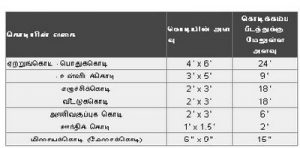
Common flag 4 ‘x 6’
The flag will be flown at all public places such as LTTE camps, government institutions, schools, cooperatives, and community organizations. The local flag will be hoisted at these places before the start of the program.
Input flag 3 ‘x 5’
The national flag may be affixed to the workshops and conference halls of heads of state, ministers, and generals. The flag should be placed to the right of the entrance inside the workshop.
Flag 2 ‘x 3’
The flag will be flown in all public places to cause an uprising.
House flag 2 ‘x 3’ erected
Any patriotic Tamil citizen can hoist the flag to their home.
The flag can be flown in front of shopping malls, factories, etc.
Parade flag 2 ‘x 3’
The flag will be used in processions.
- Flagpole and rope
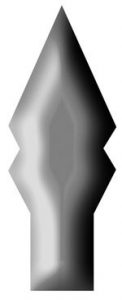
Flagpoles should be silver in the above sizes; The tip of the flagpole should be fitted with silver colored and shaped as shown here. A rope barrier should be set up to prevent the flagpole from slipping. This barrier should be 3 feet from the pedestal. The flag should be white. The flagpole should be 24 feet high from the pedestal. Where there is no pedestal, it should be 24 feet above ground level. The flagpole should be 2 inches in diameter.
- Flagstaff

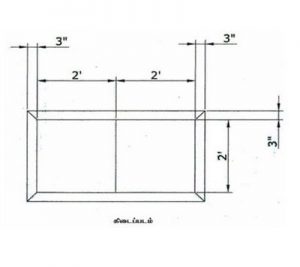
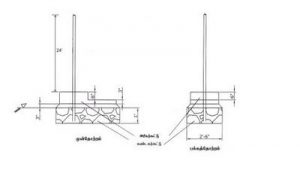
The flagpole should be one foot above the ground and 2 feet long and 2 feet wide. The front of the pedestal should be 2 feet long along with the pedestal and half a foot above the ground.
12. Flagging method
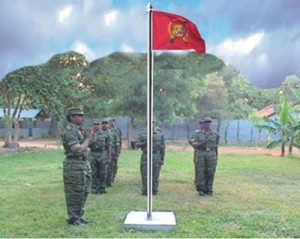
Everyone at the campus or home (excluding the patient) must attend the national flag hoisting event. Stand to the left of the flagpole and hoist the flag. The flag must be loaded with agility and right speed. Do not load with excessive speed or too slow. The flag bearer must carry the flag himself and tie the rope to the flagpole. One should assist the flag bearer to unfurl the flag while hoisting it, to ensure that the flag is in order and to ensure that the flag does not fall to the ground. When the flag bearer hoists the flag, he must step back and stand in awe. Everyone should stand in salute till the end of the flag worship.
- Flag view
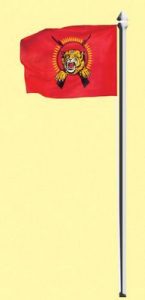
The tiger view on the flag should be opposite the flagpole.
- Time and illumination of the national flag
The national flag mounted on the flagpole must be hoisted daily after sunrise and lowered before the sun disappears.
Do not load the flag in the dim light. Therefore, if the flag should be hoisted before 6 am and after 6 pm the flag should be lighted from the pedestal to the top of the flagpole. There should also be suitable lighting at the place of the flag hoisting event.
The national flag can be flown twenty-four hours a day under full light.
The national flag must be formally unfurled before 6 pm. If the flag-raising ceremonies continue after 6 pm, the flag should be lit until the end of the show. The flag can then be hoisted down peacefully at the end of the show at night.
If the flag-raising ceremonies continue for days, the national flag may be flown continuously until the end of the procession. However, enough light must be shed so that the flag can be clearly seen. The national flag should be unfurled after the end of the program.
- National flags of other countries with our national flag
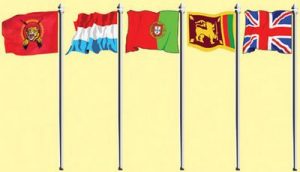
(Front view of the flagpole)
When flying the national flags of other countries with the Tamil Eelam national flag, the flags should be hoisted on the same flagpoles. To the left of the Tamil Eelam national flag, the national flags of other countries should be flown in alphabetical order of the respective countries. Flagpoles should be planted at equal intervals so that our national flag and other national flags can fly unhindered (without colliding with each other). Firstly our national flag should be hoisted alone, and then others should the others be hoisted. We must hoist our flag down after hoisted down the others.
- National flag and other flags
Our troop, patrol, brigade, local councils, departments, schools, cooperatives with our national flag. When hoisting the flags of sports clubs, clubs, etc. flags smaller than the size of the national flag should be mounted on poles 4´ feet lower than the national flagpole. This means that the national flag of Tamil Eelam should be 4´ feet higher than the other flags.
- 1. Other flags may be hoisted at equal intervals to the left of the national flag.

(Front view of the flagpole)
- 2. Seven feet from the national flagpole, the flags of the Tamil Eelam Army, Navy, and Air Force and the Police can be flown at equal intervals to the left and right of the national flag.
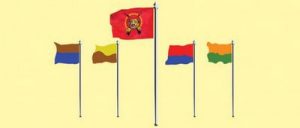
16.3. After the national flag 16. (2) the flags of the three forces and the police and the flags of the regiments may be flown at a sufficient distance after them.
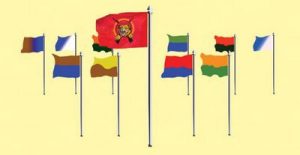
16.4. Flags of local councils, departments, schools, co-operative societies, sports clubs, clubs, etc. may also be flown as required. In cases where the flags of the three forces and the police are flown with the national flag, the above flags should be flown behind them. The above-mentioned flags and regimental flags can be flown in the same column. Flags of local councils, departments, etc. can also be flown inside the back of the stadium.
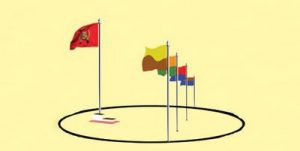
- 5. When the other flags flagged here with the national flag, the national flag must be flown in the middle of all the flagpoles higher than the other flagpoles.
Other flags should be hoisted after the national flag has been hoisted and the national flag should be hoisted down after the others have been hoisted down. When the flags are flown at half-mast, the national flag must be flown at half-mast only after the other flags have been flown at half-mast.

- Carrying the national flag in processions


In processions, the national flag must be carried to the right in front of the procession while carrying other flags. Alternatively, be carried in front of other flags in the middle. No other flag bearer should carry our national flag. The national flag should be carried straight to the chest or on the right shoulder.
- Flying the national flag on vehicles

Fly to a pole that is firmly attached to the front of the vehicle. There should be a pole two feet high above the cover of the vehicle.

The national flag can be flown on the front right side of bicycles.

The national flag should be placed on the right side of the museum and at the offices of ministers. If other flags are to be placed they should be placed to the left. The national flag should be given priority.
- Wrapping the national flag on the body
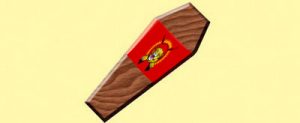
When wrapping the national flag on the body of a hero/martyr; the freedom fighter, a clearly activist of the Tamil Eelam etc. the tiger of the national flag should be at the same side of the head of the body of the hero/martyr. The wrapped national flag may be given to the relative in order to preserve it. The national flag may be flown in honor of the hero/martyr.
- Flagging during a tragic event
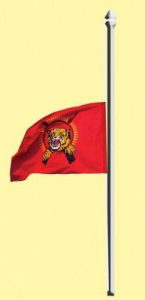
During tragic events, the national flag should be hoisted at the top of the pole and then lowered to the half-pole. When lowering the flag on the half-pole, firstly the flag should be hoisted to the top of the flagpole and then lower.
The national flag can be flown at half-mast in accordance with the formal instructions of the head office. Do not let it fly at half-mast at any other time. The instructions of the national leader should indicate how many days the national flag should be flown at half-mast.
The national flag, which is fixed to the pole, cannot be brought to the half pole during national events. At that time a 3 ‘or 2’ size black flag could be attached to the national flagpole.
- Hanging flags

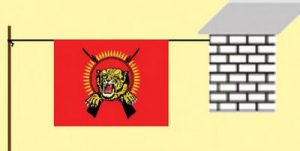
Flags can be hung high. The national flag should be so high that it does not touch any vehicle in traffic. The rope on which the flag is tied must be very firm. It is a dishonor to the country if the flag falls down.
When attaching the flag to the rope, the area above the tiger’s head should be attached to the rope. The tiger’s vision should be to the right. That is, the tiger’s look should be on the left side of the person standing in front of the flag. The tiger’s look should not be on the land or the sky.
- Flying the flag on cross poles

When the national flag of Tamil Eelam and the national flag of another country are flown at the cross poles, the national flag of Tamil Eelam should be on the right. Example, the flag should be to the left of the viewer. In addition, the pole of the Tamil Eelam national flag should be in front and the pole of the other flag should be behind.
- Flying the flag over buildings


The flag should be at the top of the pole when flying the flag horizontally or at an angle to the window sill or porch. When flying horizontally, the top of the tiger’s head should be attached to the pole so that the tiger’s gaze is to the right. When flying at an angle it should be attached in the same way as attaching the marching flag i.e. attaching the rising flag to the pole.
- National flag on platforms
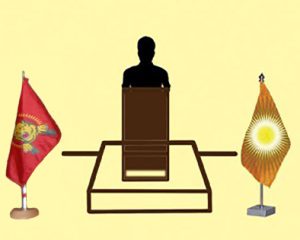

26. Hoisting down of the national flag
Hoisting down the national flag should be a special event of order. The flag bearer must be first and foremost qualified. If the flag bearer is at the end of the show he must hoist down the flag himself.
When the national flag is hoisted down, it should not fall to the ground and should be carried in the hands at a height that is within reach.
No one should raise their hand during an event where the national flag is hoisting down. The event should take place silently and quietly.
On crowded platforms, the national flag can be hoisted on the back plate above the speaker’s head. The national flag, which is 9 feet high, can be placed in front of the speaker on the right side of the stage. Other flags may be placed on the left.
- For those who organize a flag worship event
The rehearsal should be done by hoisting the national flag on the pole before the start of the event to avoid mistakes and interruptions during the event of accepting the national flag; Is the national flag straight, not upside down? Is the fold for tying the national flag rope sewn against the tiger’s vision? Is the flag in good condition without fading? If there should be hoisted other flags than the national flag? If so, are the other flags confirmed to be smaller than the national flag? Is the rope for mounting the flag less than twice the height of the flagpole and firm? Is the flagpole firmly planted? Is the flagpole high enough to carry the national flag?
All these can be done in advance to avoid any mishap or interruption in the flag hoisting event.
The responsibility of the organizer of the event is also responsible for any mistakes and interruptions at a national flag-raising event.
- Removal of the national flag
Long-term use and defective national flags should be removed according to the rules and terms. The disposal event will take place according to the prescribed method.
Gathering the defective flags
Defective flags should be gathered once every six months through the regional prefect offices. All gathering flags must be handed over to the General Secretariat.
Inspecting defective flags
All flags gathering by the General Secretariat or a competent person or staff appointed by him should be inspected to ensure that they are not defective for future use. Funerals and removal of flags that have been declared unusable should take place in a secluded place before dark in the evening.
Funeral
Select a flag that will equalize all the flags that will be removed and use it for this event. Two Red Guards (must be wearing a red parade cap) will be selected, one for the flag currently in use and the other for the flag that will be permanently retired. No less than seven people must attend this event.
The flag, which flies throughout the day, is given a rest before it dries, according to common rituals. One of the selected Red Guards will do the job. The Red Guard chosen to handle the final flag will go forward and stand in the middle. The flag will be handed over by the national leader to the responsible person for final consideration and removal. The national leader will then order the flag to be hoisted. When the flag is hoisted at the top of the flagpole with the usual rituals, the national leader will say as follows: –
“This flag has worked well for our homeland for a long time. Our nation in the future has deteriorated beyond repair. The flag equals all flags chosen today for complete retirement from service. We respect all flags by worshiping this flag.”
After the speech, the chairman will invite all the members to the attention; He will work to do the worship; Will propose the pledge. He will order the flag to rest. The Red Guard lowers the flag slowly and ceremoniously. He then folds the triangle as usual with the appropriate value and presents it to the national
leader. The committee will be dissolved and the funeral will end.
Burning ritual
The cremation ceremony will take place elsewhere. The flags will be ignited so that they can burn completely without any residue. The flag, which is folded into a triangle, is folded into a rectangle in the shade of an emerald before the ceremony begins. Everyone will stand around the fire. The national leader invites everyone to his attention. The Red Guard will come forward and set the flag on fire. Everyone will hurry up and pay their respects. After paying homage everyone will come to attention. The national leader will perform national anthems, make pledges, and speak of the power of the flag.
When the flag was hoisted, all but the national leader of the group and the Red Guard would disperse and march quietly in line. The national leader and the Red Guard would stand there and make sure the flag was completely burned. Other flags will be set on fire. The fire will be extinguished when all the flags are completely burned. The show will end with a careful burial throughout the chamber.
Thanks
Click below for more articles
தேசியக்கொடி பயன்பாட்டு விதிக்கோவை
